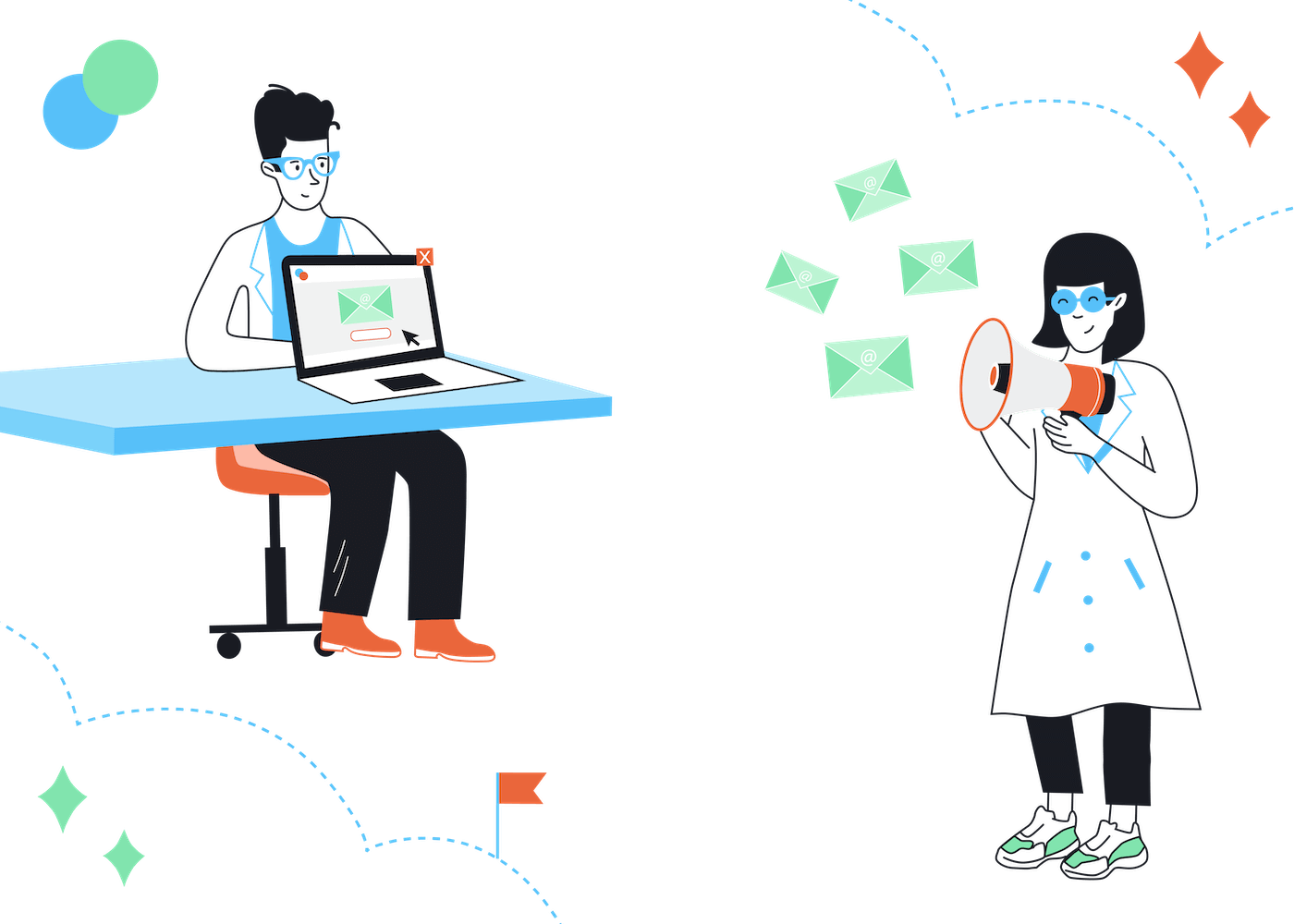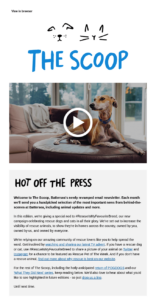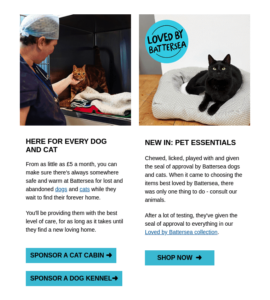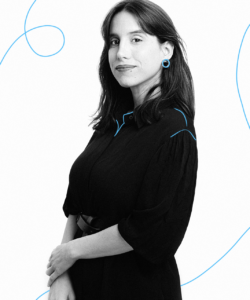Are you looking for a powerful marketing tool to amplify your brand’s voice and drive traffic to your site? Do you have stories to tell and projects to share, but don’t want to rely on social media and its random algorithm? Look no further than email newsletters – the unsung heroes of your digital arsenal.
For businesses, newsletters can serve as digital ambassadors, bridging the gap between brand and consumer. Non-profits can leverage newsletters to communicate their mission and rally supporters. Content creators can use newsletters to engage readers and share knowledge. And artists and freelancers can showcase their work and expertise through compelling messages.
As you can see, a newsletter can serve many purposes. But what exactly is a newsletter, and how does it differ from other types of marketing emails? And how can you start using them as part of your email marketing strategy?
In this article, we'll explore what newsletters are, their practical benefits, and strategies to harness their power for success in your industry.
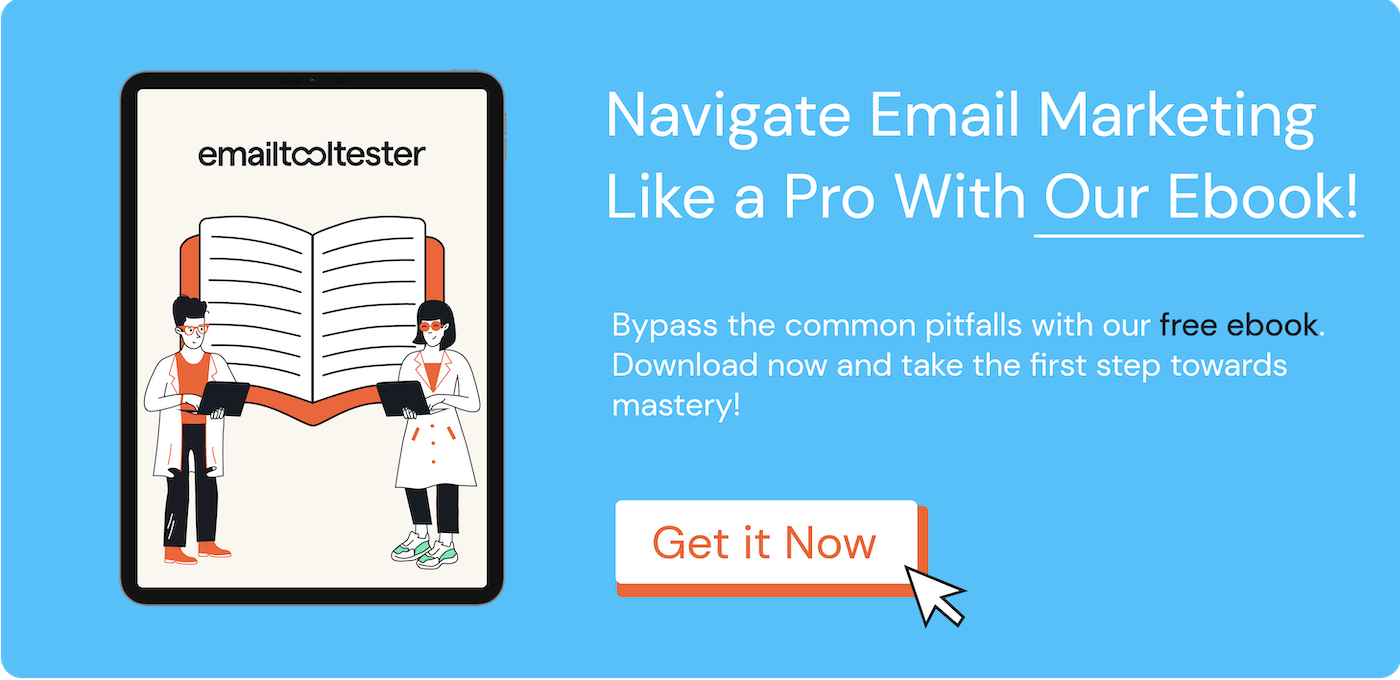
What is a Newsletter?

Our very own newsletter, which sends out email marketing tips to our EmailTooltester subscribers
Sign up for our monthly newsletter and get insider email marketing tips directly in your inbox!
Email newsletters are a powerful communication tool that allows you to deliver niche content to a relevant group of readers. They are an easy, effective and low-cost way to build and connect with an audience. Its format provides an invaluable platform that can spark meaningful conversations, build relationships, and ultimately, help to grow your revenue.
A newsletter can help you easily deliver information and share updates, news, or promotions about your brand, products, or services.
Similar to traditional printed newsletters, email newsletters aim to provide relevant and engaging content to a specific audience. They are sent to interested individuals who have subscribed to receive them, and can help to establish your brand identity while also encouraging reader interaction.
Unlike these traditional newsletters of the past though, email newsletters are much easier and cost-effective to create. They eliminate the printing, paper, and postage costs of traditional newsletters, making them a more budget-friendly option, especially if you have an affordable email service provider (ESP).
Apart from cost savings and convenience, the digital nature of email newsletters brings many additional benefits:
- Firstly, distribution is effortless. While traditional newsletters require physical distribution channels, email newsletters can be delivered instantly to a large number of recipients with just a few clicks.
- Secondly, email newsletters offer interactivity. They can include hyperlinks, videos, surveys, quizzes or social media integration, allowing readers to engage with the content immediately and take action.
- The tracking and analytics capabilities of email newsletters provide valuable insights that can help you achieve your goals and improve your marketing game. You can measure open rates, click-through rates, and other email marketing metrics to evaluate the effectiveness of your campaigns. Traditional newsletters obviously lack this level of data.
- Additionally, email newsletters enable personalization. You can tailor content based on subscriber preferences, ensuring that each recipient receives relevant and targeted information.
In short, email newsletters have revolutionized the way we communicate with our audience. What’s more, they can also offer a stepping stone into other email marketing campaigns, such as automated drip campaigns. For example, newsletter readers who click on specific links can then be nurtured with further content related to that topic.
With these advantages, email newsletters have become an essential marketing tool for businesses, organizations, and individuals looking to engage, inform, and build strong relationships with their subscribers.
The Purpose of Email Newsletters
Any newsletter – whether company, community, or interest-based – should aim to serve the following three purposes:
- Keep your audience informed: Newsletters are a great way to share updates, news, and offers related to your brand and projects. Use them to showcase your latest products, services, or blog posts, or to announce upcoming events or webinars.
- Build relationships: Newsletters help you connect with your audience on a personal level. They allow you to share your story, values, and mission, and to engage with your subscribers through polls, surveys, or Q&A sessions. Readers appreciate that your goal is not simply to advertise something, but to have a conversation!
- Drive traffic and sales: Newsletters can be a powerful tool to drive traffic to your website or store. Make sure you include links to your latest blog posts, product pages, or special offers, and encourage your subscribers to take action (with a visible call-to-action button!).
Keep these in mind when creating your newsletters – and read on to learn exactly how you can leverage newsletters in your specific field.
How You Can Use Email Newsletters in Your Industry
Email newsletters are relevant for a wide range of industries, including:
Small Businesses
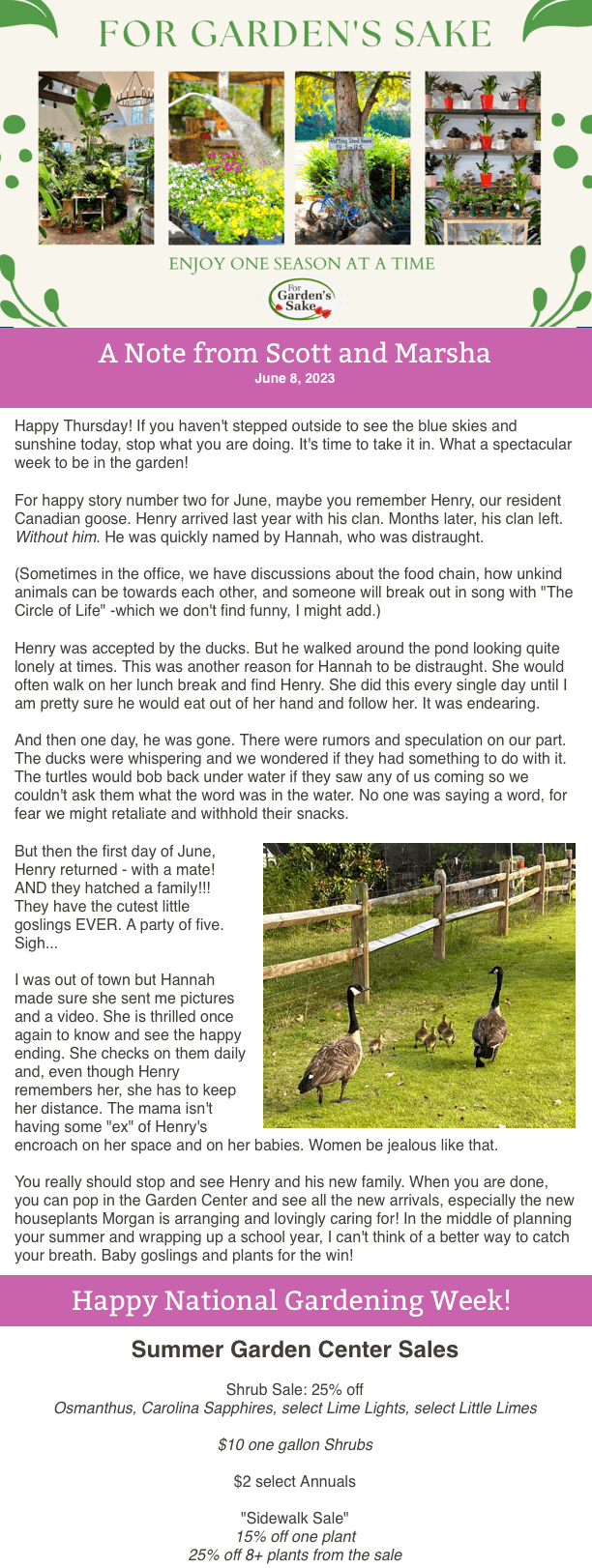
North Carolina-based garden center, For Garden’s Sake, use their newsletters to share humorous anecdotes and promote special offers
As a small business owner or marketer, newsletters become your secret weapon for staying connected with your customers. They allow you to personally address each one of them, keeping them informed about your newest products, services, or promotions.
It's a direct line of communication to their inbox, which ensures that they are always in the know about what you have to offer. This is completely different from posting on social media, and worrying if the right audience will see it or just keep scrolling. When you reach your customer’s inbox with a tailored message based on their unique interests, it’s obvious you have a much higher chance of being noticed!
Here are some examples of how you can use newsletters in your small businesses:
- Highlight new products or services: You can use newsletters to showcase your latest products or services, such as the story behind a new piece if you run a small clothing boutique. Be sure to include high-quality images, product descriptions, pricing information and clear call-to-action buttons to entice your customers to make a purchase.
- Share industry news and insights: Newsletters can also be used to share industry news and insights with your customers. Using the boutique store example again, you could share the latest fashion trends, styling tips, and outfit ideas.
- Offer exclusive promotions: Another way to use newsletters is to offer exclusive promotions to your subscribers. You can offer a discount code, free shipping, or a buy-one-get-one-free deal to incentivize your customers to make a purchase.
- Generating leads: Email newsletters can serve as a powerful tool for lead generation. By strategically incorporating lead magnets, opt-in forms, or exclusive content offers within your newsletters, you can capture new leads who can then be nurtured through targeted follow-up campaigns.
- Ask for feedback: Newsletters can also be used to ask for feedback from your customers. You can include a survey or poll in your newsletter to get feedback on your products, services, or customer service.
Non-Profit Organizations
(Click to enlarge) The monthly newsletter from Battersea Dogs & Cats Home includes a link to a video of their TV advert, as well as other updates and resources. They also include call-to-action buttons encouraging readers to donate (Source: Really Good Emails)
Newsletters don't stop at sharing information; they have the power to inspire action. If you run a non-profit, you can use newsletters to share your mission, impact, and upcoming events with supporters. They can also be used to raise awareness and funds for your cause.
Here are some ideas for using newsletters in your non-profit organization:
- Share success stories: Non-profit organizations can use newsletters to share success stories and showcase the impact of their work. For example, if you run a non-profit that provides clean water to communities in need, you can share stories of how your work has improved the lives of people in those communities.
- Promote upcoming events: Newsletters can also be used to promote upcoming events, such as fundraisers, galas, or volunteer opportunities. You can include details about the event, how to register, and how to get involved.
- Ask for donations: Another way to use newsletters is to ask for donations from your supporters. You can include a “behind-the-scenes” story that will speak to your readers’ hearts and share a call to action that encourages your subscribers to support your cause.
- Share news and updates: Newsletters can also be used to share news and updates about your organization. For example, you can share updates on your fundraising progress, new partnerships, or legislative updates that impact your cause.
Freelancers
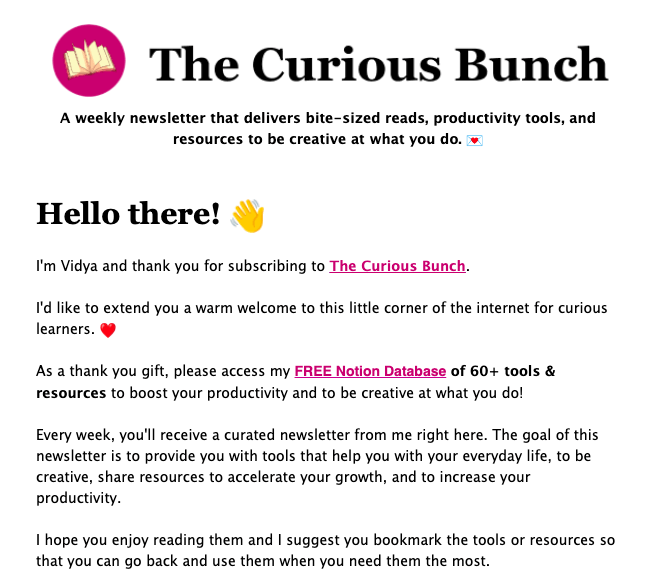
Freelance writer Vidya sends weekly tips to her content creator audience, kicking off with a welcome email that includes over 60 free resources to boost productivity
Picture this: a dynamic digital showcase that brings your talents, expertise, and creative endeavors directly to the fingertips of potential clients. So many people struggle to find a way to do that, and that’s exactly what a newsletter can do for you as a freelancer.
By sharing your projects, insightful tips, industry trends, and practical advice, you position yourself as a trusted authority, providing your subscribers with a wealth of knowledge – and spreading the word about your good work.
Some examples of how freelancers can use newsletters include:
- Showcasing your portfolio: As a freelancer, you can – and should! – use newsletters to showcase your latest projects and highlight your expertise. Make what you do clear, and include images, descriptions, and testimonials from satisfied clients to demonstrate your skills and experience. If you're a freelance photographer, for example, you could include photos and testimonials from your latest photoshoot. (If this is you, find more ideas about email marketing for photography in our guide.)
- Sharing industry insights: Newsletters can also be used to share industry insights and best practices with your subscribers, which is a great opportunity to reinforce your experience and show that you have something above the average to offer. For example, if you're a freelance writer, you can share tips on how to improve writing skills or how to find new clients. (That's exactly what copywriter Lizzie Davey does with her newsletter – you can check out her tips on how to write a compelling newsletter in this article!)
- Display availability and special deals: Another way to use newsletters is to let your readers know when you are available to take on news jobs. You can also offer discounts on some services or products.
- Asking for referrals: Newsletters can also be used to ask for referrals from your existing clients. You can include a call to action that encourages your subscribers to refer their friends and colleagues to your services.
- Offering premium subscriptions: By providing valuable and unique insights, you can entice subscribers to upgrade to a paid newsletter membership, generating recurring revenue. With the right approach, newsletters can become a profitable platform to monetize your expertise, expand your business, and create a sustainable income stream.
Ecommerce
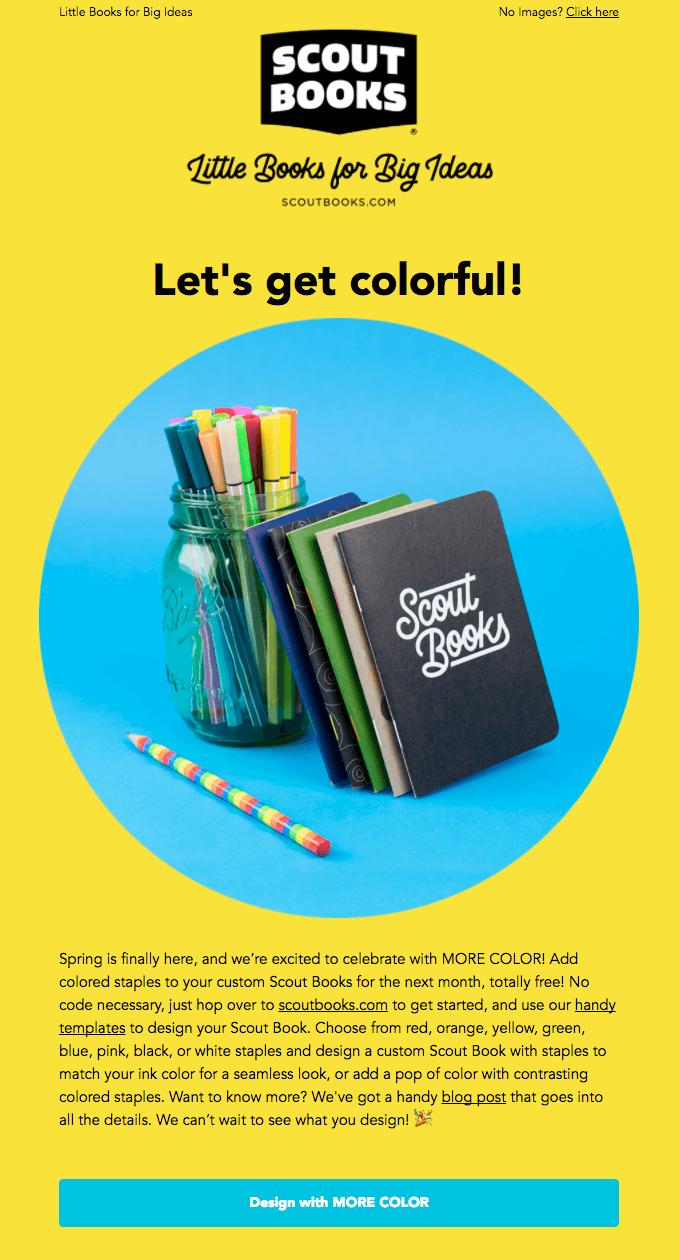
Collaborative notebook maker Scout Books use a colorful design in their newsletters to draw readers’ attention, and to promote resources on their site (Source: Really Good Emails)
If you’re an an online store owner, you can gain so much from a newsletter. Not only can you use newsletters to keep customers informed about your latest products and promotions – you can also take advantage of personalization by tailoring product recommendations based on customers' preferences.
Ideas for using newsletters in your ecommerce business include:
- Promote new products: As an online store owner, you can use newsletters to promote your latest products and collections. Again, make sure you include high-quality images, product descriptions, and pricing information and a clear call-to-action.
- Offer personalized recommendations: Newsletters can also be used to offer personalized recommendations based on your customers' browsing and purchase history. For example, if a customer has recently purchased a pair of shoes from your store, you can recommend complementary products, such as socks or a matching bag.
- Provide exclusive discounts: Another way to use newsletters is to provide subscribers with exclusive discounts or early access to sales. You can offer a discount code or a limited-time offer to incentivize your customers to make a purchase.
- Ask for reviews: Newsletters can also be used to ask for reviews from your customers. You can include a call to action that encourages your subscribers to leave a review of their recent purchase, which can help build trust and credibility for your brand.
Bloggers and Content Creators
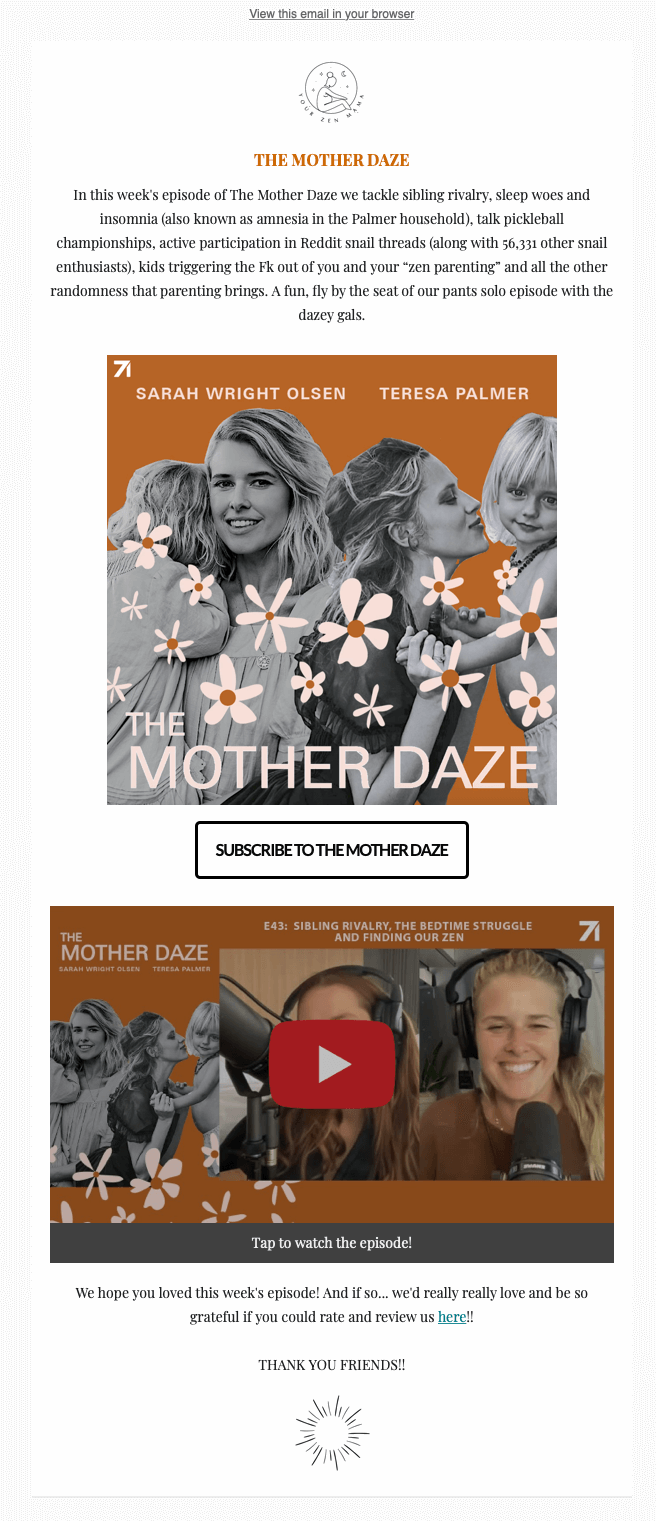
Parenthood bloggers The Mother Daze use newsletters to keep subscribers updated about their weekly podcast, as well as including a link to view it on Youtube
If you’re a content creator, newsletters can be especially great! You already have an audience deeply interested in what you have to share, so a newsletter can be the key to unlocking a direct connection with them.
They go beyond the confines of your blog and social media, allowing you to build a thriving community with people who share the same love for your niche. It’s a great way to start conversations and foster a sense of belonging among your readers.
Here are some ways you can use newsletters to grow your following (and your revenue!):
- Share new content: Use newsletters to share your latest blog posts, videos, or any content you create with your subscribers. You can include a teaser or summary of what it is about, along with a link to check the full content out.
- Offer exclusive content: Newsletters can also be used to offer exclusive content to your subscribers, such as behind-the-scenes insights, exclusive interviews, or early access to new content.
- Ask for feedback: Another way to use newsletters is to ask for feedback from your readers. You can include a survey or poll in your newsletter to get feedback on what you have been sharing. This can help you understand what kind of content they expect from you.
- Promote affiliate products: Newsletters can also be used to promote affiliate products or services that align with your audience. You can include a review or recommendation of the product, along with an affiliate link that earns you a commission for each sale. Make sure you let your readers know that this is an easy way for them to help you continue on this content journey.
- Cross-promotion and collaboration opportunities: Newsletters provide an opportunity to cross-promote with other businesses or influencers in your industry. By featuring guest contributors, partnering with complementary brands, or offering exclusive discounts or collaborations, you can expand your reach, tap into new audiences, and benefit from the collective expertise and network of others.
Restaurants and Hospitality Providers
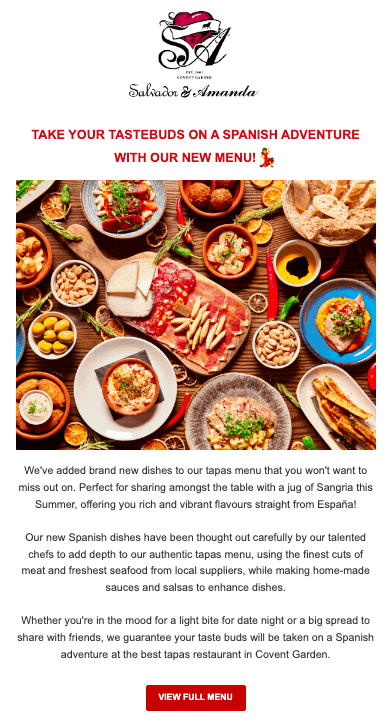
London-based tapas restaurant Salvador & Amanda use animated GIFs in their newsletters to promote new menus, enticing readers to come try them out
If you run a restaurant, newsletters should be an integral part of your restaurant email marketing strategy. Regularly engaging with your audience through newsletters helps foster customer loyalty and retention.
Not only this is a great way to display beautiful food photos and make your readers hungry, it’s also an easy way to share valuable content, exclusive offers, or updates on new products or services. By keeping customers informed and interested, they are more likely to return for future dining experiences.
Some ideas for using newsletters as part of your restaurant’s marketing strategy include:
- Highlighting new menu items and specials: You can include mouth-watering images, descriptions, and pricing information to entice your customers to make a reservation.
- Promoting upcoming events: Newsletters can also be used to promote upcoming events, such as wine tastings, live music, or themed dinners. You can include details about the event, how to make a reservation, and what to expect.
- Offering exclusive content and discounts: You can share content such as recipes and also offer exclusive discounts or coupons to your subscribers, like a free appetizer with their next meal, to incentivize your customers to visit your restaurant.
- Asking for feedback: A newsletter for a restaurant can of course also be used to ask for feedback from your customers. You can try to find out your readers’ favorite dishes from your menu and include a survey or poll in your newsletter to get feedback on your service or atmosphere.
Best Practice Tips for Creating and Sending Newsletters
After all this, I’m sure you now agree that a newsletter marketing strategy can bring many benefits. Unfortunately, you're not the only one to think so – businesses all around the world have been leveraging newsletters to fuel their growth for quite some time now.
So how can you make sure your newsletter is successful? Based on our experience, there are some essential tips that you shouldn't overlook.
Here are our recommendations for creating and sending effective newsletters:
- Define your goals and audience: Before creating your newsletter, define your goals and audience. What do you want to achieve with your newsletter? Who is your target audience? What is your niche?
- Send only to subscribers: The key to getting consent is to emphasize the value of your newsletter and reach the right readers. Give your website visitors an easy opportunity to subscribe on your website with a newsletter signup form that tells them exactly what they’ll be getting in return. You can also encourage signups through social media, search ads, and your email signature.
- Choose a consistent format: This includes the layout, design, and tone of voice. Keep it organized with eye-catching visuals, and make sure it’s informative.
- Use a catchy subject line: Craft subject lines that grab your subscribers' attention and entice them to open your newsletter. We have a free subject line previewer for you to test some ideas and preview how it is displayed on mobile devices.
- Personalize your content: Personalize your content based on your subscribers' preferences and behavior.
- Include a clear call to action: Encourage your subscribers to take action, such as visiting your website or store, and make it easy for them to do so with clear CTA buttons and links.
- Test and optimize: Improve your newsletter's performance by analyzing your data insights and making changes based on your subscribers' behavior. For example, you could run A/B tests, or experiment with different newsletter sending times, to find the optimal mix for your business.
What is a Newsletter: Conclusion
Email newsletters are a versatile and powerful marketing tool that can help you achieve marketing goals. They are a fun and effective way to engage with your audience and make them feel connected to your brand and content.
By tailoring your newsletter's content to resonate with your target audience, you not only add value to your subscribers, but also establish a strong sense of community, creating a perfect opportunity to engage online presence for your brand and grow your business.
So, don't underestimate the power of email newsletters. It's time to roll up your sleeves, connect with your audience, and experience firsthand the tangible impact of well-crafted newsletters.
Get started today by checking out the following resources:
> Find the right newsletter service with our smart quiz
> Calculate the cost of sending a newsletter based on your list size
> Learn how to create a newsletter step-by-step
> Download these free email newsletter templates
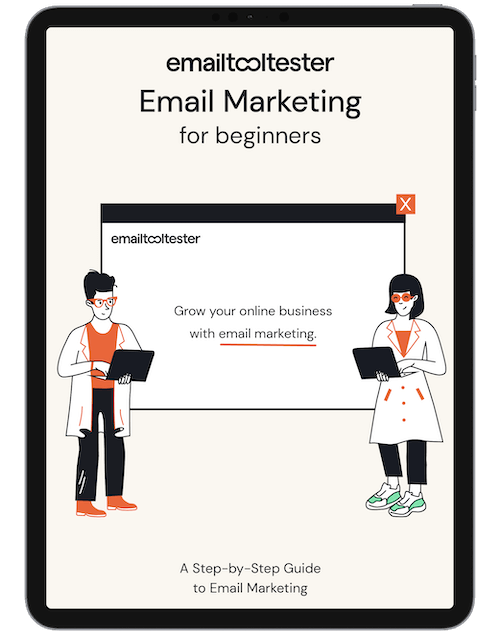
Email Marketing: Beginners Guide
Ideal for small & medium-sized businesses, online stores and bloggers. Avoid common mistakes with this complete guide.
Sign up to receive your free copy!
Our Methodology
This article has been written and researched following our EmailTooltester methodology.
Our Methodology